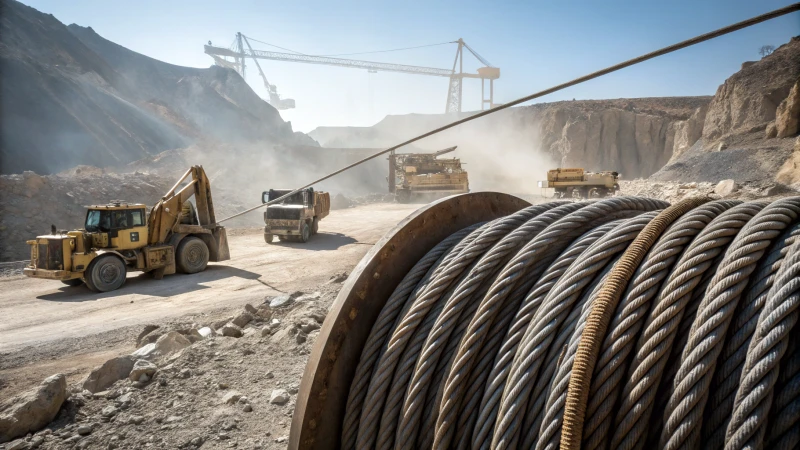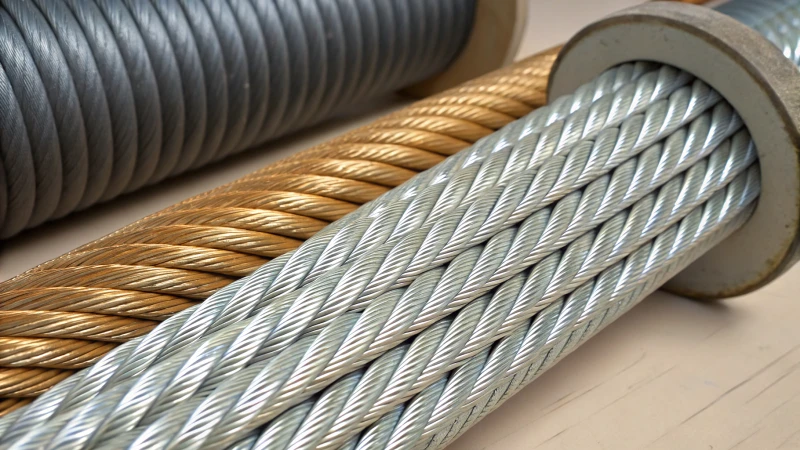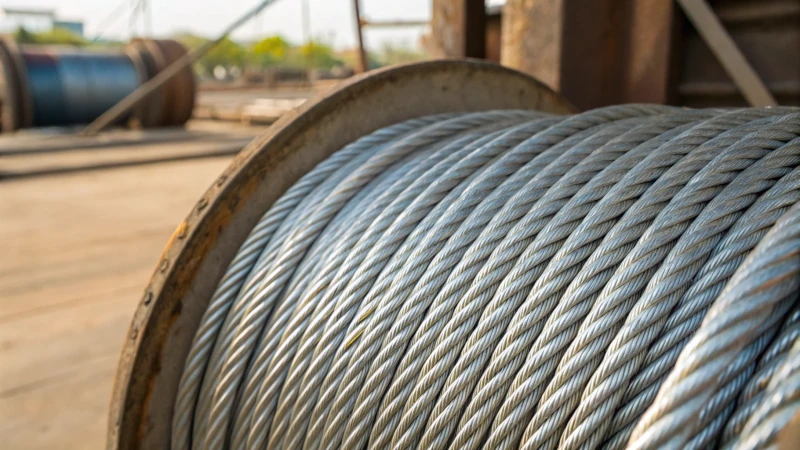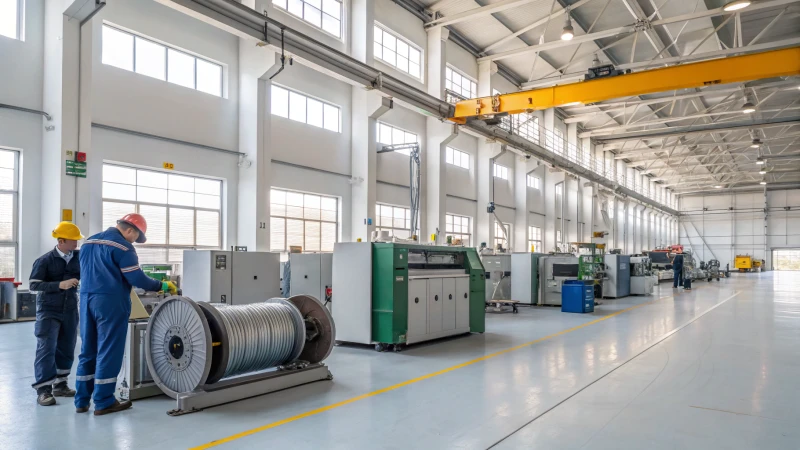
Ever wondered how to keep mining operations running smoothly despite harsh conditions?
Steel wire ropes enhance corrosion resistance in mining operations by using protective coatings like zinc and aluminum, or by utilizing stainless steel materials. Galvanized wire ropes provide at least 50% better corrosion resistance than standard steel ropes, making them crucial for safety and efficiency in challenging mining environments.
I remember standing at the edge of a vast mining site, watching the machinery and feeling a mix of awe and anxiety. The relentless exposure to moisture and chemicals made me appreciate the importance of corrosion-resistant materials. It’s not just about extending the life of the equipment; it's about ensuring the safety and reliability that mining operations depend on. Coatings like zinc and aluminum act as shields, while stainless steel offers unmatched durability. These innovations are not just technical improvements—they're safeguards that keep operations on track and personnel safe. As we delve deeper into the earth, these advancements become not just beneficial but essential.
Galvanized ropes offer 50% better corrosion resistance.True
Galvanized wire ropes provide significantly enhanced corrosion resistance in mining.
Stainless steel ropes are less corrosion-resistant than zinc-coated ropes.False
Stainless steel is generally more resistant to corrosion than zinc-coated steel.
What are the different types of coatings used on steel wire ropes?
Steel wire ropes might seem mundane, but their coatings are unsung heroes in harsh environments. Curious about how they protect and enhance performance?
Steel wire ropes often use coatings like galvanized zinc, plastic (PVC or nylon), and stainless steel. These coatings boost corrosion resistance, extend lifespan, and enhance performance, crucial for industrial applications.

I remember the first time I had to decide on the right coating for steel wire ropes for a project. It felt like choosing a jacket for an unpredictable climate—both must offer protection against the elements while being durable enough to withstand the wear and tear of daily use.
Galvanized Zinc Coatings
Galvanizing steel wire ropes with zinc is akin to giving them a protective shield against the elements. I recall standing at a construction site, watching the ropes endure the relentless weather without a hint of rust, thanks to this coating. It’s a cost-effective solution that ensures longevity in corrosive environments by letting the zinc take the hit before the steel does.
Advantages:
- Affordable and effective
- Extends lifespan in corrosive settings
- Offers sacrificial protection with zinc
Plastic Coatings: PVC and Nylon
When it comes to plastic coatings, I’ve seen firsthand how they can transform the flexibility and durability of ropes. Imagine needing ropes that can withstand saltwater during a marine project—PVC is your go-to. On another occasion, when dealing with high-tension scenarios, nylon provided that extra strength we desperately needed.
| Comparison Table: | Feature | PVC Coating | Nylon Coating |
|---|---|---|---|
| Flexibility | Moderate | High | |
| Abrasion Resistance | Moderate | Excellent | |
| Typical Use | Marine, Landscaping | High-tension Applications |
Stainless Steel Coatings
Stainless steel ropes are like the indomitable warriors of wire ropes—no extra coatings needed, just pure resilience. I’ve seen these ropes thrive under extreme conditions, resisting rust with ease. They’re perfect for situations where maintenance is challenging but performance is non-negotiable.
Key Benefits:
- Superb corrosion resistance
- Minimal upkeep required
- Versatile in wet and dry settings
Aluminum Coatings
Less talked about but equally effective in certain scenarios, aluminum coatings offer superior corrosion resistance in salty atmospheres. They also reduce heat absorption—a feature that came in handy during one particularly scorching project.
Choosing the Right Coating
Selecting the perfect coating feels like tailoring a suit to fit the specific needs of your project environment. If you’re like me, working near saltwater or under heavy mechanical stress, opting for stainless steel or PVC could be your best bet due to their saltwater resistance. And while it might seem daunting at first, focusing on factors like cost1, durability, and environmental conditions will steer you towards the optimal choice2 for your situation.
Galvanized coatings offer sacrificial protection to steel ropes.True
Zinc corrodes before steel, providing a protective barrier.
Nylon coatings are less flexible than PVC coatings.False
Nylon coatings offer higher flexibility compared to PVC.
How Does Galvanization Improve the Durability of Wire Ropes?
Ever wonder how wire ropes stand up to the harshest conditions without a hitch?
Galvanization significantly boosts the durability of wire ropes by coating them with zinc, preventing rust and corrosion. This protective layer ensures the ropes perform reliably in challenging environments, extending their lifespan.

Understanding Galvanization Process
I remember the first time I really understood the importance of galvanization. Picture this: a chilly morning on a construction site, and I'm standing next to a colleague who's explaining how the zinc coating on our wire ropes is the unsung hero against rust and corrosion. "It's like an invisible armor," he said, and it clicked for me. Galvanization is crucial, especially in industries where exposure to the elements is unavoidable. The most common method, hot-dip galvanizing3, involves submerging wire ropes in molten zinc, creating a robust barrier against moisture and chemicals.
Benefits of Galvanized Wire Ropes
- Corrosion Resistance: Imagine the zinc layer as a brave knight defending the steel underneath. It acts as a sacrificial anode, taking the hit so the steel doesn’t have to. This makes galvanized ropes about 50% better4 at resisting corrosion compared to their ungalvanized counterparts.
- Cost-Effectiveness: You might think the initial investment is steep, but trust me, it pays off. Fewer replacements and repairs mean you save money in the long run.
| Property | Galvanized Ropes | Ungalvanized Ropes |
|---|---|---|
| Corrosion Resistance | High | Low |
| Maintenance Frequency | Low | High |
| Initial Cost | Higher | Lower |
Applications in Harsh Environments
I've seen firsthand how galvanized wire ropes shine in demanding settings like mining, marine, and construction industries. For example, during my time working closely with mining operations5, it was clear that deeper underground activities demand materials that can withstand extreme conditions. Galvanized ropes are perfect for these tasks.
Comparing Galvanization Types
When it comes to choosing the right type of galvanization, understanding your options is key:
- Electro-galvanizing offers a smoother finish through electroplating but is less thick than other methods.
- Hot-dip galvanizing provides a thicker coating, making it ideal for heavy-duty applications.
For someone like John6 or Emma7, knowing these differences can make all the difference in sourcing the right materials to ensure both durability and compliance with industry standards. I've seen how informed decisions in procurement can lead to significant improvements in project outcomes.
Galvanization involves coating with zinc for corrosion resistance.True
Galvanization uses zinc to protect wire ropes from rust and corrosion.
Electro-galvanizing is thicker than hot-dip galvanizing.False
Hot-dip galvanizing provides a thicker, more robust zinc coating.
Why is stainless steel preferred in certain mining applications?
Imagine standing in the heart of a bustling mine, where every piece of equipment faces relentless pressure and harsh conditions. What makes stainless steel the go-to choice here?
Stainless steel is preferred in mining because it resists corrosion, offers exceptional strength, and boasts durability. These properties help withstand challenging environments, lower maintenance costs, and boost safety and efficiency.

The Role of Corrosion Resistance
I remember the first time I walked through a mining site; the air was thick with moisture and the smell of earth. Equipment seemed to bear the marks of their harsh surroundings. This is exactly why stainless steel is a hero in such settings. Its secret? Chromium. When added to steel, chromium forms a protective layer that stands guard against rust, effectively prolonging the life of mining machinery and cutting down on those pesky replacement expenses. This feature significantly extends the lifespan of mining equipment, reducing replacement costs in corrosive environments8.
Strength and Durability
During one of my visits to a mine, I marveled at the sheer strength required for operations like hoisting massive loads. Stainless steel steps up to the plate here as well, offering high tensile strength that’s essential for such heavy-duty tasks. It's like the reliable friend who never lets you down, ensuring equipment keeps going even when conditions are at their worst. This means fewer interruptions and more peace of mind in extreme conditions9.
Cost-Effectiveness Over Time
Initially, stainless steel might seem like the pricier option. But here's where it pays off: its long-lasting nature and minimal maintenance needs lead to significant savings over time.
| Material Type | Initial Cost | Maintenance Cost | Lifespan |
|---|---|---|---|
| Stainless Steel | High | Low | Long |
| Carbon Steel | Low | High | Short |
This shows why investing in stainless steel is akin to making a smart financial decision10 for any mining company aiming to streamline operations.
Safety and Regulatory Compliance
In my experience, safety always comes first, especially in industries like mining. Stainless steel doesn't just meet safety standards; it excels by maintaining its integrity under pressure, safeguarding workers and complying with strict regulations. Knowing this helps procurement managers like John or Emma feel confident about their material choices while adhering to industry regulations11.
Stainless steel reduces equipment replacement costs in mining.True
Its corrosion resistance extends equipment lifespan, lowering replacements.
Carbon steel is more cost-effective than stainless steel in mining.False
Initial costs are lower, but maintenance and shorter lifespan increase expenses.
How Can Future Technologies Revolutionize Corrosion Resistance?
Have you ever felt the weight of rust eating away at critical machinery? I know I have, and it's not a great feeling. But there’s hope on the horizon with future technologies poised to revolutionize corrosion resistance.
Self-healing coatings, nanotechnology, and advanced alloys are set to transform corrosion resistance by extending the lifespan of materials in harsh environments. These innovations promise enhanced durability, reducing maintenance needs and costs.

Self-Healing Coatings
Picture this: you're watching your favorite action movie, and the hero’s car heals itself after a dramatic crash. It sounds far-fetched, right? But in the world of materials science, self-healing coatings are making this a reality. Imagine a coating that can self-repair cracks or scratches on steel wire ropes used in construction or mining—virtually eliminating the need for constant maintenance. It's like giving your equipment superpowers to withstand the harshest conditions. This technology significantly reduces12 the need for maintenance by maintaining a protective barrier.
Nanotechnology Enhancements
Now, let's talk about tiny warriors—nanoparticles. When I first learned about nanotechnology, it felt like something out of a sci-fi novel. But here we are, utilizing nanoparticles to enhance corrosion resistance. By integrating these microscopic particles into coatings, they block moisture and oxygen from penetrating, offering unparalleled protection. It's like dressing your equipment in an invisible shield that’s always ready for battle.
| Nanoparticle Type | Benefits |
|---|---|
| Graphene | High electrical conductivity |
| Zinc oxide | UV protection and antibacterial |
| Silica | Improved mechanical properties |
These tiny particles improve the barrier properties and provide superior resistance against13 corrosion at a microscopic level.
Advanced Alloys
When it comes to advanced alloys, I remember the first time I handled a piece of duplex stainless steel. It was heavier than expected but promised incredible strength. These new alloys are crafted to resist even the most aggressive environments, making them ideal for deep mining operations where traditional materials might falter. Alloys such as duplex stainless steels offer enhanced corrosion resistance14 due to their unique microstructures.
Bio-inspired Solutions
Finally, nature as our guide—bio-inspired solutions are like having nature's best kept secrets in our toolbox. Drawing inspiration from structures like mollusk shells or lotus leaves leads to surfaces that repel water effortlessly. This natural mimicry not only prevents corrosion but also pushes the boundaries of what we thought possible in material science.
Bio-inspired approaches lead to development of15 hydrophobic surfaces that prevent corrosion.
As these technologies continue to evolve, they offer more than just enhanced durability—they represent a leap forward in cost efficiency and safety across various sectors. These innovations are not just about preserving materials; they’re about building a future where corrosion is no longer a formidable foe but a challenge that technology is ready to conquer.
Self-healing coatings can repair themselves when damaged.True
Advanced polymers and healing agents enable self-repair of coatings.
Graphene nanoparticles provide UV protection in coatings.False
Graphene offers high electrical conductivity, not UV protection.
Conclusion
Steel wire ropes enhance mining operations' corrosion resistance through coatings like zinc and aluminum, or stainless steel, ensuring safety, durability, and efficiency in harsh environments.
-
Learn how zinc galvanization provides effective corrosion resistance for steel wire ropes in various applications. ↩
-
Discover why stainless steel wire ropes are preferred for durability and performance in demanding industrial environments. ↩
-
Learn about the hot-dip galvanizing process and its protective benefits for wire ropes. ↩
-
Explore research highlighting the superior corrosion resistance of galvanized wire ropes. ↩
-
Discover why galvanized wire ropes are essential in mining operations. ↩
-
Understand John’s role in selecting durable materials for construction. ↩
-
Explore Emma’s focus on sourcing high-performance mining equipment. ↩
-
Learn how stainless steel's corrosion resistance extends equipment lifespan in mining applications. ↩
-
Discover how stainless steel maintains its strength and reliability in tough mining conditions. ↩
-
Explore how using stainless steel can lead to long-term cost savings in mining operations. ↩
-
Understand how stainless steel helps meet safety regulations in the mining industry. ↩
-
Discover how self-healing coatings work and their applications in industrial settings to enhance material durability. ↩
-
Learn about the role of nanotechnology in improving corrosion resistance through innovative material design. ↩
-
Explore how advanced alloys are engineered for superior corrosion resistance in extreme environments. ↩
-
Find out how bio-inspired designs are leading to innovative corrosion-resistant materials. ↩

